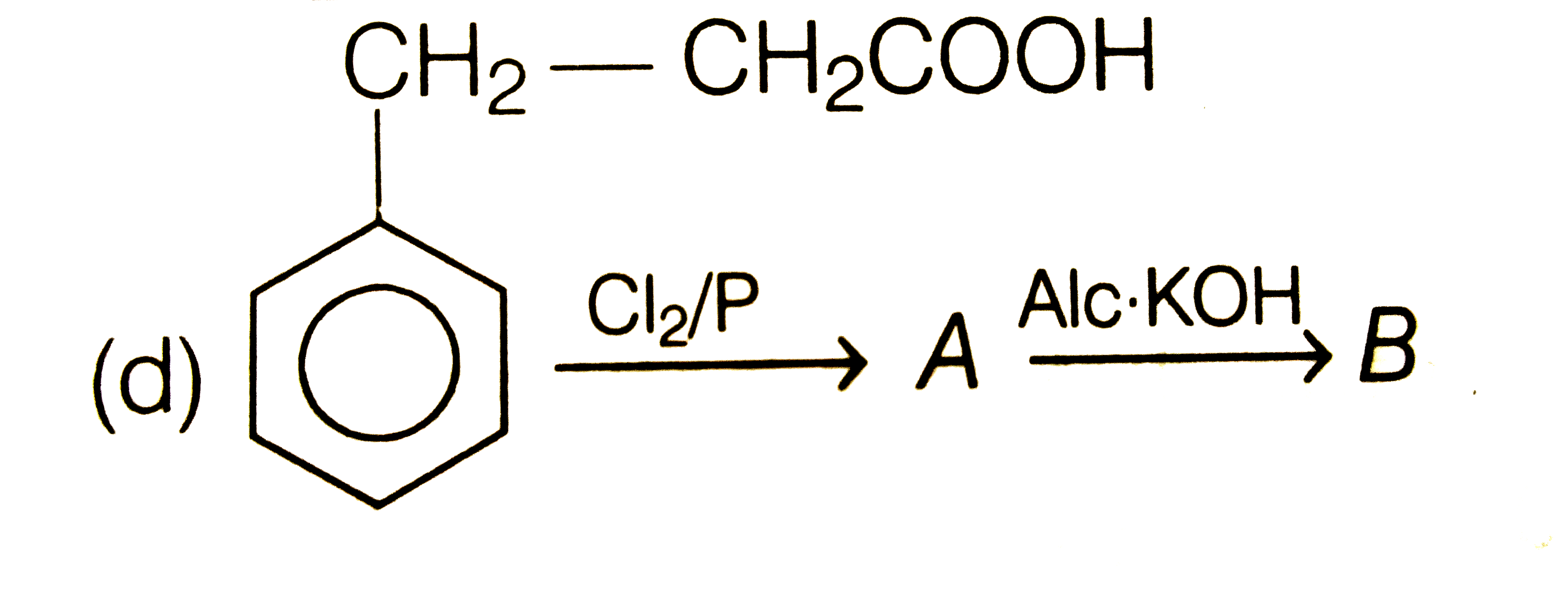Identify A, B, C , -------- in the following.
CH3CH2CH2MgBrNH3−−→ABr2−−−→127∘CBNa−−→etherC
To solve the problem step by step, we will identify the compounds A, B, and C based on the provided reactions.
Step 1: Identify A
We start with the Grignard reagent, CH₃CH₂CH₂MgBr. When this Grignard reagent is treated with ammonia (NH₃), the nucleophilic alkyl group (CH₃CH₂CH₂-) reacts with the proton (H⁺) from ammonia. This results in the formation of a primary amine.
Reaction:
CH3CH2CH2MgBr+NH3→CH3CH2CH2NH2+MgBr+
Compound A:
A=CH3CH2CH2NH2 (n-propylamine)
Step 2: Identify B
Next, we take compound A (n-propylamine) and treat it with bromine (Br₂) at 127°C. The bromine will react with the alkyl group to form a radical, which can then combine with bromine to form an alkyl bromide.
Reaction:
CH3CH2CH2NH2+Br2→CH3CHBrCH2+HBr
Compound B:
B=CH3CHBrCH2 (2-bromopropane)
Step 3: Identify C
Finally, we treat compound B (2-bromopropane) with sodium (Na) in the presence of ether. This is a Wood's reaction, which leads to the coupling of two alkyl halides, resulting in the formation of an alkene.
Reaction:
2CH3CHBrCH2+Na→CH3C=CCH3+NaBr
Compound C:
C=CH3C=CCH3 (2-butene)
Summary of Compounds
- A: CH₃CH₂CH₂NH₂ (n-propylamine)
- B: CH₃CHBrCH₂ (2-bromopropane)
- C: CH₃C=CH₂ (2-butene)
We start with the Grignard reagent, CH₃CH₂CH₂MgBr. When this Grignard reagent is treated with ammonia (NH₃), the nucleophilic alkyl group (CH₃CH₂CH₂-) reacts with the proton (H⁺) from ammonia. This results in the formation of a primary amine.
CH3CH2CH2MgBr+NH3→CH3CH2CH2NH2+MgBr+
A=CH3CH2CH2NH2 (n-propylamine)
Next, we take compound A (n-propylamine) and treat it with bromine (Br₂) at 127°C. The bromine will react with the alkyl group to form a radical, which can then combine with bromine to form an alkyl bromide.
CH3CH2CH2NH2+Br2→CH3CHBrCH2+HBr
B=CH3CHBrCH2 (2-bromopropane)
Finally, we treat compound B (2-bromopropane) with sodium (Na) in the presence of ether. This is a Wood's reaction, which leads to the coupling of two alkyl halides, resulting in the formation of an alkene.
2CH3CHBrCH2+Na→CH3C=CCH3+NaBr
C=CH3C=CCH3 (2-butene)
- A: CH₃CH₂CH₂NH₂ (n-propylamine)
- B: CH₃CHBrCH₂ (2-bromopropane)
- C: CH₃C=CH₂ (2-butene)
Similar Questions
Knowledge Check
- Question 1 - Select One
CH3CH2CH3Cl2−−−−−→hvABr2−−−−−→hbB
A and B are :ACH3CH2CH2Cl and CH3Br∣CH−CH2−ClBCH3Cl∣CHCH3 and CH3Br∣CHCH2−ClCCH3Cl∣CHCH3 and CH3Cl∣CH−CH2−BrDCH3Cl∣CHCH3 and CH3−Cl∣C∣Br−CH3 - Question 2 - Select One
CH3COOHCa(OH)2−−−−−→ACa(OOCH)2−−−−−−−→ΔBNH2OH−−−−→C
A BCH3CH=NOHCH2C==NOHD
BCH3CH=NOHCH2C==NOHD
- Question 3 - Select One
CH3CH2COOHBr2−−→red PABr2−−→B
What is B?ACH3CH2BrBCH3CH2CHOCCH3−C∣BrH−COOHDBr−CH2−CH2−COOH
Identify A and B in the following sequence of reactions:
CH3CH2BrKCN−−→ALiAlH4−−−→B.View SolutionIdentify the compounds A, B and C in the following reaction :
CH3−BrMg/ether−−−−−→(A)(i)CO2−−−−−→(i)Water(B)CH3OH/H−−−−−−→Δ(C)View SolutionIdentify the major product in the following reactions :
C6H5−CH2−H∣C∣Br−CH3Alc.KOH−−−−−→Δ?HBr−−→ ?View SolutionCH3BrNa−−→ether[A]Br2−−→hv[B]Na−−→ether[C]
View SolutionCH3−Br+NaO−CH3∣C∣CH3−CH3→ ?
View Solution

